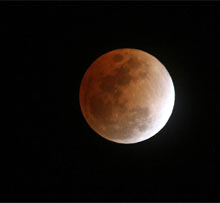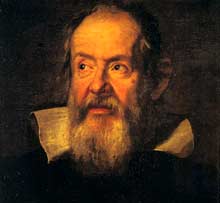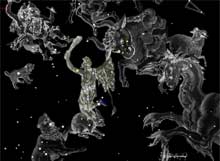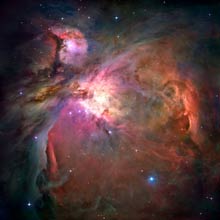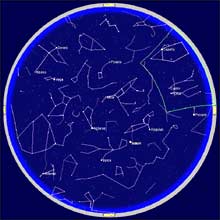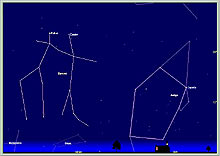(See update.)

December 30, 2008
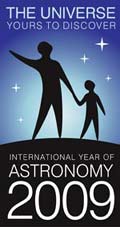  Life and editing happened, and I didn’t manage to tell you about some of the best skywatcher’s resources I use until it was too late to put them under the tree, or the menorah, or the Festivus pole, as the case may be, as fitting presents for the International Year of Astronomy. Life and editing happened, and I didn’t manage to tell you about some of the best skywatcher’s resources I use until it was too late to put them under the tree, or the menorah, or the Festivus pole, as the case may be, as fitting presents for the International Year of Astronomy.
I use them to fact check Joe Rao’s “Skylog” column—an assignment I at first found incredibly intimidating. But in doing so, I’ve inevitably become more aware of the sky—at least, as much as is visible from the lamentably light-polluted urbs I live in: the phases of the Moon, the brilliant apparitions of Venus, whatever constellation is directly overhead. Because of this recurring assignment, its regularity so soothingly astronomical, I knew there would be a total lunar eclipse on my husband’s birthday last February, and could drag him outside to see the Moon immersed in the Earth’s shadow. It was the classic mistake of giving the present you really want for yourself: he had quite enough of skygazing the winter he was 18, lying in an open coal car escaping from a Soviet prison camp. Never having had to fear freezing to death, I have the luxury of looking up and out and being thrilled that something so microbially tiny can make eye contact with the cosmos. The splendors the Hubble has fished out of its depths only make the naked-eye view more enticing.
Whether you have a skygazing jones or know someone who does, whether you live under a sky still encrusted with undimmed stars or are contemplating travel to such places, you may find the following resources useful and enlightening if you don’t know them already. (Confirmed skywatchers, please add your own reviews of these, or further suggestions.)
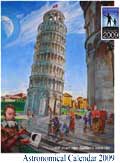  Guy Ottewell’s Astronomical Calendar, the 2009 edition still available, is a unique marriage of science and art by a living, breathing denizen of the Renaissance. (When on my predecessor’s instructions I ordered this beautiful, comprehensive, and quirky sky atlas, it was something of a reunion: I’d actually met the polymathic Ottewell forty years ago, when he showed up at the publishing house where I was a baby editorial assistant, as the “representative” of the elusive “Jecon Gregory,” nomad author of a mysterious memoir we’d just published called History of a Nation of One.) It’s appropriate that Galileo appears in this year’s cover painting; as the credit line says, “All illustrations are by Guy Ottewell, except those by Galileo Galilei.” The Calendar satisfies the mind and the soul at once, with profiles and diagrams of each month’s astronomical events; detailed tables of lunar and planetary motions for the year; special articles on 2009’s asteroids, comets, meteors, conjunctions and occultations; orbital diagrams, star charts, and much more, interlarded with quotes and poems by and about Galileo and others. It’s an educational tool as well: the first page begins, “FOR THE BEGINNER—TEACH YOURSELF ASTRONOMY WITH THIS CALENDAR.” And it will beguile you into doing just that, even if you started out relying on it (as you famously can) for its facts. (There are other astronomical resources to browse at Ottewell’s Universal Workshop, including a sky guide for kids.) Guy Ottewell’s Astronomical Calendar, the 2009 edition still available, is a unique marriage of science and art by a living, breathing denizen of the Renaissance. (When on my predecessor’s instructions I ordered this beautiful, comprehensive, and quirky sky atlas, it was something of a reunion: I’d actually met the polymathic Ottewell forty years ago, when he showed up at the publishing house where I was a baby editorial assistant, as the “representative” of the elusive “Jecon Gregory,” nomad author of a mysterious memoir we’d just published called History of a Nation of One.) It’s appropriate that Galileo appears in this year’s cover painting; as the credit line says, “All illustrations are by Guy Ottewell, except those by Galileo Galilei.” The Calendar satisfies the mind and the soul at once, with profiles and diagrams of each month’s astronomical events; detailed tables of lunar and planetary motions for the year; special articles on 2009’s asteroids, comets, meteors, conjunctions and occultations; orbital diagrams, star charts, and much more, interlarded with quotes and poems by and about Galileo and others. It’s an educational tool as well: the first page begins, “FOR THE BEGINNER—TEACH YOURSELF ASTRONOMY WITH THIS CALENDAR.” And it will beguile you into doing just that, even if you started out relying on it (as you famously can) for its facts. (There are other astronomical resources to browse at Ottewell’s Universal Workshop, including a sky guide for kids.)
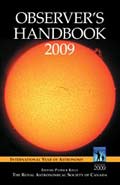  The Royal Astronomical Society of Canada’s 101-year-young Observer’s Handbook 2009 is more compact and less colourful (as they say up there), but packed with even more pages of astronomical data and elucidation, some of it different from and therefore indispensably complementary to Ottewell’s Calendar. In addition to the fundamentals the two books share in their vastly different styles, there’s a long, detailed section on the optics of observing with the naked eye, binoculars, and telescopes; another on the optics of such solar epiphenomena as “rainbows, halos, sundogs, pillars, coronae, glories, and heiligenschein;” essays on light pollution and its abatement; a list of upcoming “star parties” in Canada and the U.S., complete with weather probabilities for each date and location, and more—all peppered with piquant observations. You probably knew that time is “nature’s way of keeping everything from happening at once,” but did you know that “Mass is a measure of sluggishness of response to a net force,” or that “The eye does not detect the colours of the rainbow; the brain creates them”? The Royal Astronomical Society of Canada’s 101-year-young Observer’s Handbook 2009 is more compact and less colourful (as they say up there), but packed with even more pages of astronomical data and elucidation, some of it different from and therefore indispensably complementary to Ottewell’s Calendar. In addition to the fundamentals the two books share in their vastly different styles, there’s a long, detailed section on the optics of observing with the naked eye, binoculars, and telescopes; another on the optics of such solar epiphenomena as “rainbows, halos, sundogs, pillars, coronae, glories, and heiligenschein;” essays on light pollution and its abatement; a list of upcoming “star parties” in Canada and the U.S., complete with weather probabilities for each date and location, and more—all peppered with piquant observations. You probably knew that time is “nature’s way of keeping everything from happening at once,” but did you know that “Mass is a measure of sluggishness of response to a net force,” or that “The eye does not detect the colours of the rainbow; the brain creates them”?
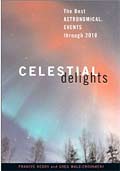  The third book I use to confirm Joe’s sky forecasts has two years left to run (and so you can get it from Amazon for a penny or a dollar): Celestial Delights: The Best Astronomical Events Through 2010, by Francis Reddy and Greg Walz-Chojnacki. (It began with 2003.) The book will be useful even after that, though (and will hopefully be reissued for another “week” of years), because its lucid essays on astronomical phenomena enfold a great deal of the history of astronomy, from the world’s sky mythologies through the early development of science and technology and the great discoveries that have studded astronomy’s timeline. This book reveals the sky as not only a simultaneous orchestration of light from different depths of time and distance, but as a palimpsest of ideas from all eras of human culture, where mythological names and figures intertwine with the radical formulae of astrophysics—confirming Guy Ottewell’s sense of an intimate collaboration across the centuries. The third book I use to confirm Joe’s sky forecasts has two years left to run (and so you can get it from Amazon for a penny or a dollar): Celestial Delights: The Best Astronomical Events Through 2010, by Francis Reddy and Greg Walz-Chojnacki. (It began with 2003.) The book will be useful even after that, though (and will hopefully be reissued for another “week” of years), because its lucid essays on astronomical phenomena enfold a great deal of the history of astronomy, from the world’s sky mythologies through the early development of science and technology and the great discoveries that have studded astronomy’s timeline. This book reveals the sky as not only a simultaneous orchestration of light from different depths of time and distance, but as a palimpsest of ideas from all eras of human culture, where mythological names and figures intertwine with the radical formulae of astrophysics—confirming Guy Ottewell’s sense of an intimate collaboration across the centuries.
I am sure there are astronomical resources online far beyond what I’m aware of (and again, suggestions are invited). At the risk of making veteran skywatchers go “Duh,” here are three I rely on, two for data and one for visual guidance:

- The U.S. Naval Observatory (USNO) has recently upgraded and expanded its publicly available data services. Now included are rise and set times not only for the Sun and Moon but for all major solar system objects and significant stars; duration of daylight/darkness tables as well as those of civil, nautical, and astronomical twilight (new concepts to me when I began this job); eclipse computers, geocentric and topocentric positions of sky objects, and much more.
- Old Farmer’s Almanac Astronomy Center is where I went for rise and set times of the planets before USNO provided them, and still will, because it’s so quick and easy to use: you just enter your geographic location and the date of interest.
- Sky & Telescope Magazine’s SkyChart Interactive allows you to see the sky, in both 360° overhead and horizon views, from any location at any quarter-hour on “any date from 1600 to 2400,” including major constellations (which light up as you mouse over them), bright stars, the planets and Moon.
I hope your lucky star is one of the ones you see up there in 2009.

In a special issue, Nature kicks off the International Year of Astronomy, which celebrates the 400th birthday of Galileo’s breakthrough and "“seeks to remind us of the humbling nature of gazing at the heavens.” Nature also takes a serious look at the alarming extent of light pollution, and presents some strong arguments for bringing back the dark.



(Annie Gottlieb) |
Comments (add yours!)

Return to November-December home
|


